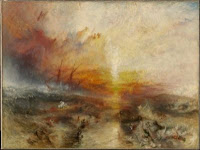The Corcoran Gallery of Art is currently holding an exhibition called “Turner to Cezanne: Masterpieces from the Davies Collection.” The Davies sisters were two British art collectors who accumulated a large number of European works from the mid 19th century to the early 20th century. Despite acquiring works over a fifty-year span, there is a similar theme seen throughout their collection because the subjects of their art are either landscapes or intimate portraits. There are no modern scenes of everyday city life. As a result, I was able to see how landscape paintings and portraiture developed throughout time in England and France because the exhibit was arranged chronologically by style.
 |
| Turner, The Storm, 1840-1845, Corcoran |
Due to their British heritage, the sisters first focused on collecting British artwork in order to enhance cultural life within England. The British painter Joseph Mallord William Turner was the first artist showcased in the exhibit. His work, The Storm, painted in 1840-1845, reminded me of another work of his, The Slave Ship. Painted at the same time, around the end of Turner’s career, both seascapes deal with nature and the sublime. Although the two paintings have different color palettes, the painting technique is similar
 |
| Turner, Slave Ship, 1840, MFA Boston |
ships seen in their backgrounds. In addition, the remains of the ship’s sails in The Storm are reminiscent of the slave’s hands as both emerge from the angry waves. As the boat is destroyed by the forceful waves, there is an emphasis on the power of nature in The Storm. Nonetheless, in person, the painting is very small and some of the affect is lost on the viewer.
 |
| Millet, The Good Samaritan, 1846, Corcoran |
*Picture of Slave Ship: http://www.mfa.org/collections/search_art.asp?recview=true&id=31102
*Picture of The Good Samaritan: http://www.jeanmillet.org/The-Good-Samaritan,-1846.html
*Picture of The Good Samaritan: http://www.jeanmillet.org/The-Good-Samaritan,-1846.html
No comments:
Post a Comment